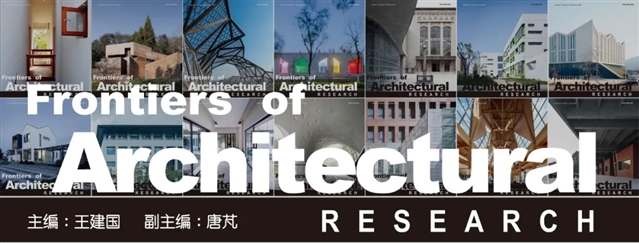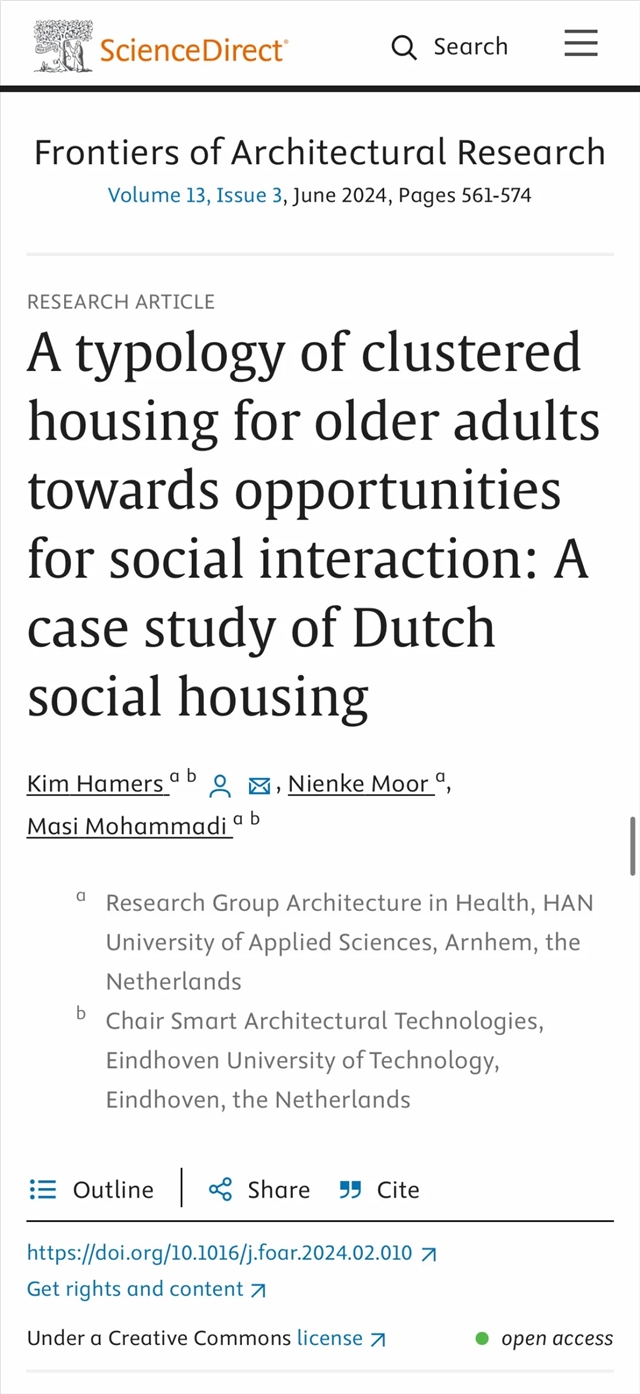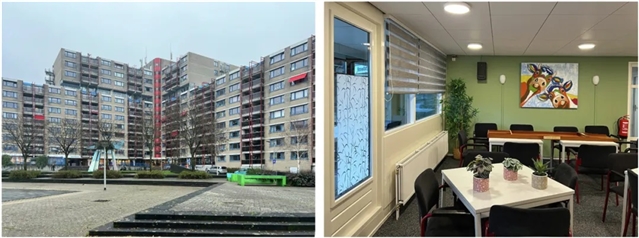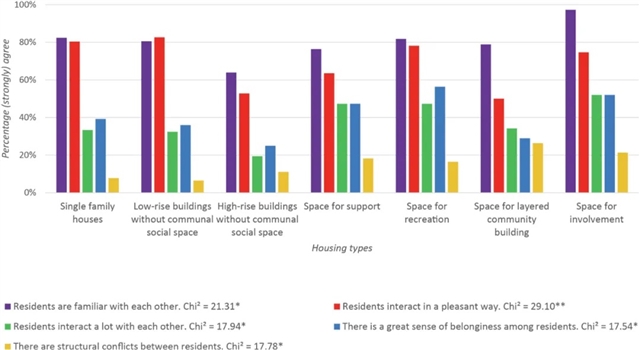|
|
|
|
|
FoAR 一种为老年人提供社交互动机会的集群式住宅类型:荷兰社会性住宅案例研究 |
|
|
论文标题:A typology of clustered housing for older adults towards opportunities for social interaction: A case study of Dutch social housing
期刊:Frontiers of Architectural Research
作者:Kim Hamers, Nienke Moor, Masi Mohammadi
发表时间: 15 Jun 2024
DOI: 10.1016/j.foar.2024.02.010
微信链接:点击此处阅读微信文章

FoAR是由高等教育出版社和东南大学建筑学院联合主办的全英文学术期刊
建筑学 / 城乡规划 / 风景园林
本刊已被 A&HCI / CSCD / Scopus / DOAJ / CSTPCD 收录

01论 文 题 目
Manuscript Title
A typology of clustered housing for older adults towards opportunities for social interaction: A case study of Dutch social housing
一种为老年人提供社交互动机会的集群式住宅类型:荷兰社会性住宅案例研究
02作 者
Authors
Kim Hamers (a)(b)* , Nienke Moor (a), Masi Mohammadi (a)(b)
(a) Research Group Architecture in Health, HAN University of Applied Sciences, Arnhem, the Netherlands
(b) Chair Smart Architectural Technologies, Eindhoven University of Technology, Eindhoven, the Netherlands
03论 文 摘 要
Abstract
Dutch housing associations are dealing with a growing number of tenants who are ageing in place. Meanwhile, there is a lack of suitable housing that meets the (social) needs of this target group. Clustered housing, which offers a socio-spatial context that facilitates encounters between residents, is considered a promising housing concept to (partly) fill this gap. However, clustered housing is a broad concept consisting of a variety of housing types that differ from each other in the extent to which people “live together”.Still little is known about which types of clustered housing can be distinguished in relation to the potential for social interaction. Therefore, in this article we distinguish between types of clustered housing based on social, organizational, and spatial building characteristics. We have mapped these characteristics by combining real estate data of housing association Woonzorg Nederland with survey data collected among their building managers. Based on this dataset, an explorative cluster analysis was performed, resulting in four types of clustered housing. Finally, further exploration of the data shows that, from the perspective of building managers, residents of certain types of clustered housing interact more often and feel more connected with each other than residents of non-clustered housing types.
面对越来越多的老年住户,荷兰住宅协会正在解决满足这一群体社交需求的住宅不足问题。集群式住宅可以提供这样一个社会空间环境,促进居民间的接触,被认为是一种非常有前途的住宅概念,(部分)填补了这一需求的空白。然而,对这些“住在一起”的人们来说,集群式住宅又是一个特别宽泛的概念,因其包含有各种类型的住宅,彼此差异很大。至于哪种类型的集群式住宅可以更加有助于社交互动,我们仍知之甚少。因此,在本文中,我们根据住宅的社会特点、组织特点,以及空间特点来将不同类型的集群式住宅区分开来。我们通过将住宅协会——Woonzorg Nederland的房地产数据与从他们的建筑经理那收集的调查数据相结合,绘制出了这些特征。基于该数据集,我们进行了一项探索性聚类分析,总结出了四种类型的集群式住宅。最后,对数据的进一步探索表明,从建筑管理者的角度来看,某些类型的集群式住宅居民比非集群式住宅居民社交互动更为频繁,彼此之间的联系也更紧密。
04关 键 词
Keywords
Clustered housing / 集群式住宅
Typology / 类型学
Seniors / 老年人
Social housing / 社会性住宅
05章 节 标 题
Sections Title
1. Introduction / 引言
1.1. Senior housing in the Netherlands / 荷兰老年人住宅
1.2. Community-based housing and the well-being of its residents / 基于社区的住宅及其位居民们所带来的福祉
1.3. Characteristics of clustered housing in the social rental sector / 社会租赁房屋领域中集群式住宅的特征
2. Theory / 理论
2.1. Social interaction and cohesion in the residential environment and its consequences for well-being / 居住环境中所包含的社会互动与凝聚力及其对人们幸福感所产生的影响
2.2. The spatial, social, and organizational layers of clustered housing in relation to social interaction and cohesion / 集群式住宅中与社会互动性和凝聚力相关的空间、社会和组织层面
3. Material and methods / 研究内容与研究方法
3.1. Data on technical complexes / 技术综合体的数据
3.2. Data & operationalization / 数据与操作过程
3.3. Cluster analysis / 聚类分析发
4. Results / 研究成果
4.1. Description of types of non-clustered housing / 非集群式住宅类型的说明
4.2. Cluster analysis for exploring types of clustered housing / 采用聚类分析法来探索集群式住宅的类型
4.2.1. Space for support / 支持空间
4.2.2. Space for recreation / 互动空间
4.2.3. Space for layered community building / 社区建筑的分层空间
4.2.4. Space for involvement / 介入空间
4.3. An initial exploration of the social added value of (types of) clustered housing, from the perspective of building managers / 从建筑管理者的角度对集群式住宅(类型)的社会附加价值进行初步探索
5. Discussion / 结论
06主 要 插 图
Illustrations

▲ 图一:属于住宅类型“支持空间”的技术综合体示例。在这座建筑(以前是护理院)中,住宅协会与一个护理组织合作,为可以独立生活以及内部生活的老年人提供住宅单元。居民们并不需要太多参与生活环境的社会和空间方面的组织行为,但有很多机会在公共区域遇到其他居民,如餐厅、图书馆、花园,或在有组织的活动中。© Woonzorg Nederland

▲ 图二:属于住宅类型“娱乐空间”的技术综合体示例。在这座中型建筑(由47个住宅单元组成)中,居民主要参与规划和组织活动,这些活动可以在公共空间(娱乐室)和公共花园中进行。© Woonzorg Nederland

▲ 图三:一个技术综合体的例子,属于住宅类型中的“社区建筑分层空间”。在这个大型建筑(分布在12层的189个住宅单元)中,一楼有两个相邻的公共空间,由居民自己组织(社会)活动。© Research group Architecture in Health

▲ 图四:属于住宅类型“介入空间”的技术综合体的例子。在这座中型建筑中,居民可以使用公共活动室、图书馆、洗衣房和客房进行社交活动。建筑中流通区域的设计促进了居民之间的自然相遇。在这座建筑中,租户委员会是社区背后的推动力。此外,居民还参与了一些任务,如组织活动,管理和维护公共区域和户外空间。© Woonzorg Nederland

▲ 图五:Exploration of the social environment in the residential building, by housing type. Percentage of the residential buildings of which the building manager provided a valid answer and agrees (strongly) with the statements in the legend. Note: survey data and real estate data collected in collaboration with the housing association involved; own calculations, N(tc) Z 449. c2 -test for difference between housing types: *r < 0.01, **r < 0.001。© 本文作者
07作 者 介 绍
Authors’ Information
Kim Hamers
Doctoral Candidate
Chair Smart Architectural Technologies
Eindhoven University of Technology, the Netherlands

Nienke Moor
Researcher
Research Group Architecture in Health
HAN University of Applied Sciences, the Netherlands

Masi Mohammadi
Full Professor
Chair Smart Architectural Technologies
Eindhoven University of Technology, the Netherlands
As the principal investigator and leader of the research program ‘Empathic Environment’, an ongoing interdisciplinary study into technological and social aspects of smart healthy neighborhoods, Mohammadi aims to develop an evidence-based framework for embedding emerging technologies (such as domotics, AI, robotics and IoT) into architectural concepts and systems. Therefore, it is essential to create a delicate balance between architecture, technology and the actual needs and preferences of (end) users. By implementing these (design) principals and methods in several Living Labs throughout the Netherlands, her chair aims to explore the next generation smart homes, and to examine the impact of these interventions on the socio-spatial context and real life of users. This new cross-disciplinary field requires systematic research and the development of new methodologies to empirically evaluate emerging housing typologies and their impact on the health, wellbeing and social engagement of users. To facilitate these advances 17 PhD and PDEng researchers are currently conducting research on this subject.
08原 文 阅 读
Download Link

长按上方二维码|浏览本期精彩论文
▼ 点击下方词条 | 往期精彩不容错过
#期刊快讯#系列
1/ 主编王建国院士团队荣获国家科技进步奖一等奖
2/ FoAR|2021年度报告,2022新年快乐!
3/ FoAR|2022年度报告,2023新年快乐!
4/ FoAR|2023年度报告,2024新年快乐!
5/ JCR最新|FoAR 2023年度影响因子3.1,两项评价指标均位列WoS核心合集建筑类第一
6/ 最新|FoAR 2023 CiteScore 指数上升为6.2
7/ 最新|FoAR 被中国科技论文与引文数据库(CSTPCD)收录
8/ 最新|FoAR 再次入选中国国际影响力优秀学术期刊
9/ 最新|FoAR 荣获科爱十大优秀期刊奖
10/ 最新|FoAR进入2023年中国科学院分区表1区
#新刊上线#系列
2024年第一期
2024年第二期
2024年第三期
#FoAR投稿指南#系列
1/ 投稿流程
2/ Guide for Author中文版
3/ 审稿流程及发表流程
4/ 如何提交修改稿
5/ 录用文章出版流程
#期刊知识科普#系列
1/ SCI之父尤金·加菲尔德的传奇人生
2/ 国际核心期刊数据库大解析
3/ 手把手教你如何使用最强工具Web of Science
4/ 如何发现一本好期刊
5/ 国内核心期刊有哪些
6/ 版面费与期刊影响力
#精彩文章#系列精选
01/ 城市设计实践发展的多元维度——基于UAL的案例研究
02/ 从智慧城市到共情城市
03/ 传统阿拉伯伊斯兰城市居住区形态学:以传统城市大马士革为例
04/ 建筑遗产预防性保护的意大利视角
05/ 生物与建筑:将科学知识与设计实践相结合的六家法国建筑事务所项目案例研究
06/ 颇具争议的渐进式改造:Elemental建筑事务所金塔蒙罗伊公屋居住区项目的15年
07/ 联合眼动实验和SD法的传统商业街区视觉效果感知评价
08/ 历史的层次:古城堡遗迹中的新建筑改造
09/ 通过空间句法检验帕拉第奥别墅平面中的控制性、中心性和灵活性
10/ 自1931年柯布西耶的Salubra色卡问世后其建筑色彩的偏好:一种跨文化的分析
11/ 建筑师身份的描绘:1920年代末的中国美术建筑师——刘既漂
12/ 探索暴露于风影响下织物的表达与功能
13/ 绿色屋顶能否在地中海气候条件下显著节约能源?基于不同案例的批判性评估
14/ 芬兰近期落成的原木建筑的建构及建筑品质:相关建筑师的解读
15/ 新加坡高校教室光环境品质研究
期刊联络
高等教育出版社: 010-58556484
东南大学:025-83795543
刊物邮箱:foar@pub.seu.edu.cn
FoAR英文期刊交流QQ群:21608832
在线投稿
www.editorialmanager.com/foar
刊物主页
http://www.sciencedirect.com/science/journal/20952635
http://journal.hep.com.cn/foar
《前沿》系列英文学术期刊
由教育部主管、高等教育出版社主办的《前沿》(Frontiers)系列英文学术期刊,于2006年正式创刊,以网络版和印刷版向全球发行。系列期刊包括基础科学、生命科学、工程技术和人文社会科学四个主题,是我国覆盖学科最广泛的英文学术期刊群,其中12种被SCI收录,其他也被A&HCI、Ei、MEDLINE或相应学科国际权威检索系统收录,具有一定的国际学术影响力。系列期刊采用在线优先出版方式,保证文章以最快速度发表。
中国学术前沿期刊网
http://journal.hep.com.cn

特别声明:本文转载仅仅是出于传播信息的需要,并不意味着代表本网站观点或证实其内容的真实性;如其他媒体、网站或个人从本网站转载使用,须保留本网站注明的“来源”,并自负版权等法律责任;作者如果不希望被转载或者联系转载稿费等事宜,请与我们接洽。